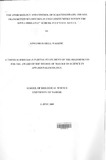| dc.description.abstract | Evidence from recent literature indicates that schistosomiasis remains a major public
health problem in developing countries even in the 21st century. Schistosoma mansoni
can infect all members of a population but the most vulnerable group with the highest
rate of infections is found in children between the ages of 5 and 15 years. Praziquantel is
currently the drug of choice for the treatment of all schistosome species occurring in man.
The main objective of this study was to investigate the infection and reinfection pattern of
Schistosomiasis in school going children after 3 years of therapeutic intervention with
praziquantel.
Four parasitological surveys were carried out in two pnmary schools in Mwea, an
irrigation scheme region in central Kenya after 3 years of mass chemotherapy. Two
thousand one hundred and eight pupils aged between five and twenty four years were
examined for Schistosoma mansoni infection by Kato thick smear technique.
A total of 100 homesteads were sampled on the aspects of risk factors that were believed
to play a role in the transmission of schistosomiasis and Soil Transmitted Helminthes
(STH). Malacological surveys were also conducted to evaluate the temporal variation in
both vector and cercarial densities. The study involved parasitological surveys in two
communities with different geographical settings. The study showed that prevalence of
infection was 22.7 and 31.1 before treatment, and 6.99 and 8.73 after treatment in Mianya
and Mukou respectively. Malacological surveys revealed the presence of 3 species of
freshwater snails, namely Biomphalaria pfeifferi, Physca acuta, and Bulinus
globossus. The risk factor survey provided qualitative and quantitative data on hygiene
and sanitation, water contact and the shoe wearing practice.
One of the schools is placed in the Mwea Township (Mukoujwhile the other is placed in
the village (Mianya), yet there was no major difference in the transmission, reinfection or
water contact patterns. Though the prevalence of soil trab~mitted helminthes is quite low,
intestinal Schistosomiasis is still prevalent among the. primary school children in the
irrigation scheme even after 3 years of mass chemotherapy. Infection and reinfection of
schistosomiasis among the school chi.ldren has therefore been observed even after
treatment with praziquantel and the study recommends among other measures non
selective mass chemotherapy in the study area. | en |

